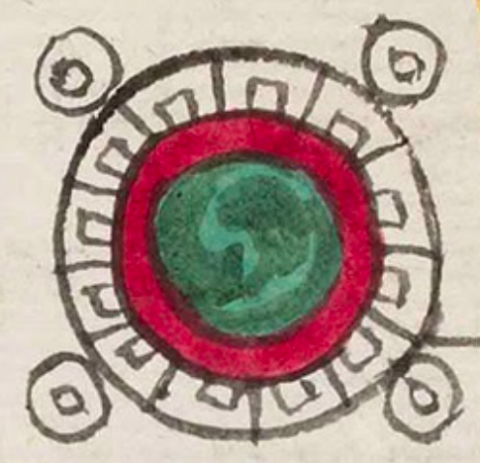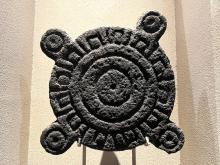chalchihuitl (Mdz3v)
This simplex glyph of a chalchihuitl (jade, precious green stone) stands for the place name Chalco. The -co (locative suffix) is not represented visually. It consists largely of concentric circles outlined in black. The center is a large circle with three inner circles. The innermost circle is painted a dark green, with some lighter green variations. The ring around that is a solid red color, and the outer ring is white with twelve divisions and, within each division, a square. Around the outside of the outermost ring are four small circles, placed somewhat equidistant from one another. Each of these circles also has an inner, concentric circle.
Stephanie Wood
The stone that this glyph evokes, local jade, held a deep preciosity. It was a metaphor for children, and it was an early tribute item. The effect of the black and white ring with divisions and little squares is to create something like a radiating essence from the gem in the middle. The impact of the four points on the external ring is to recall a quatrefoil (or a quincunx, if we recognize the center, too), either the four cardinal directions or celestial phenomena. See also our entries for olin and tonatiuh, which have similar quincunx shapes. The sign for tonatiuh also has four small circles on its outer ring, each with a smaller concentric circle. See also tezcatl and xihuitl glyphs, which appear to also have a shine or shimmer.
The four small circles around the edge of the stone are also reminiscent of the small concentric circles that splash like droplets off of the currents of water (atl), which are sometimes themselves seen by scholars as chalchihuitl gems. A carved stone glyph of a chalchihuitl was found on a house in Mexico City, as published by Mexicolore. This one has no remaining easily visible color, although other known stone carvings of chalchihuitl have had coloring. It has one additional inner circle, and the outer circle has more than twelve divisions, but there is nevertheless a strong resemblance to the Chalco glyphs in the Mendoza. That the number of divisions in the outermost ring can vary in different known chalchihuitl glyphs is also attested in the way the one in the Mapa de Sigüenza only has eight divisions. That these divisions might have an age-old antecedent in petroglyphs is suggested in figures 1e and 1f in a study by Anthony F. Aveni and Horst Hartung, "The Cross Petroglyph."
The two shades of green and the mottled or swirling effect of chalchihuitl may convey something of the shape of the stone, but it can also be one of the things that links it to water in the Nahua perception. The hieroglyph for water has shells and water droplets (which some see as chalchihuitl gems) splashing off of it. Loic Vauzelle notes that "one of the subsidiary names for Chalchiuhtlicue" is Acueye, which means "She Who Has a Water Skirt," and Vauzelle identifies additional relationships between water and jade. ["Clothes with Metaphorical Names and the Representation of Metaphors in the Costumes of the Aztec Gods," in Katarzyna Mikulska and Jerome A. Offner, Indigenous Graphic Communication Systems (Louisville: University Press of Colorado, 2019), esp. p. 158.]
The red ring around the green stone may be a metaphorical passage to an interior, like a shore around a body of water. See our study of red and yellow liners that contain bodily and earthly interiors. Janice Robertson (2017, 193) sees the red around the chalchihuitl as having the purpose of pulsating as the eye oscillates between the "diametrically opposed colors."
In personal communications (12/2022), Allison Caplan shared her interpretation of the "fringe" outside the red ring, which she sees as feathers with the calamus marked. She added in 1/2023 how she sees: "the green-red-and-white bar extensions from the sun disk as the same fringe that surrounds the chalchihuitl glyph--a red contour line, a fringe of white feathers with the calamus marked, and a jade bead." She has also wondered "whether this edge for jade is a way of evoking its sensoriality."
That, said, the green stone was only used in this compound glyph to call forth the phonetic "chal," meaning "in the hollow." The place does not really have a significance relating to the precious stone.
Stephanie Wood
Stephanie Wood
c. 1541, but by 1553 at the latest
Stephanie Wood
Joseph Scott and Crystal Boulton-Scott made the SVG.
chalchihuitl. Museo Nacional de Antropología e Historia, Salón Mexica. Photograph by Stephanie Wood, 14 February 2023.

chalchihui(tl), precious green stone, https://nahuatl.wired-humanities.org/content/chalchihuitl
jade, a precious green or blue stone
jade, piedra preciosa verde o azul
Stephanie Wood
Codex Mendoza folio 3 verso, https://digital.bodleian.ox.ac.uk/objects/2fea788e-2aa2-4f08-b6d9-648c00..., image 17 of 188.
The Bodleian Libraries, University of Oxford, hold the original manuscript, the MS. Arch. Selden. A. 1. This image is published here under the UK Creative Commons, “Attribution-NonCommercial-ShareAlike 3.0 License” (CC-BY-NC-SA 3.0).





